
Disha Gupta


Enabling sellers with a clear and effective sales enablement strategy can make the difference between simply meeting and consistently exceeding quotas.
Sales enablement is about enabling sellers with the resources, tools, and knowledge they need to engage effectively with customers and close deals more efficiently. While many organizations have recognized the value of a sales enablement plan—incorporating educational resources, advanced sales technology, meticulously crafted content, and a comprehensive sales playbook—the need for a periodic refresh of this strategy is often overlooked.
As markets shift, customer behaviors change, and new technologies emerge, a static sales enablement strategy may quickly become outdated, losing its impact and leaving sales teams struggling to adapt. By embracing a culture of continuous improvement and aligning sales enablement practices with current trends and organizational goals, businesses can ensure their sales force remains agile, informed, and ahead of the competition.
This article explores the importance of sales enablement and emphasizes the need for regularly revisiting and revitalizing your strategy.
Sales enablement is the process of providing sales teams with the necessary content, leadership, tools, and training to maximize their productivity and efficiency. This provides salespeople with the necessary resources at every stage of the sales process, for any customer type, and for any of their product’s solution areas.
But the success of your sales enablement strategy doesn’t just depend on the granular details, which are easy to replicate from one strategy to the next. Ultimately, the success of your sales enablement strategy depends on how clearly you define the vision and scope of sales enablement, and how well you execute it.
Sales enablement strategies have become essential for businesses looking to boost their sales operations and drive revenue growth. Companies can significantly enhance productivity and effectiveness by providing sales teams with the necessary tools, content, and training.
There are several benefits of implementing a comprehensive sales enablement strategy. Each benefit helps create a more agile, informed, and effective sales force, capable of meeting the market’s ever-changing demands and exceeding customer expectations.
Implementing a sales enablement strategy significantly boosts sales productivity by providing sales teams with the tools, content, and training they need to work more efficiently. Sales representatives spend less time searching for the right information and materials, and more time engaging with prospects and customers. With streamlined processes and easy access to essential resources, sales teams can focus on selling rather than administrative tasks, leading to more meaningful interactions and a higher volume of sales activities.
Sales enablement tools, like CRMs and content management platforms, automate many of the time-consuming tasks associated with sales, like data entry and content creation. This automation allows sales reps to manage their pipelines more effectively, ensuring that they can follow up on leads and opportunities in a timely manner. The result is a more productive sales force that can achieve higher quotas and contribute more significantly to the company’s bottom line.
A well-crafted sales enablement strategy improves the effectiveness of sales teams by ensuring they have the right skills, knowledge, and resources to engage prospects successfully. Through targeted training and onboarding programs, sales reps become more adept at understanding customer needs, presenting solutions, and closing deals. This not only increases the likelihood of winning new business but also helps in building stronger, more profitable customer relationships over time.
Sales enablement ensures that sales teams have access to up-to-date, relevant content that resonates with prospects and customers. With a deep understanding of the product offerings and a rich repository of sales materials, sales reps can tailor their interactions to their audience’s specific interests and pain points, significantly increasing the effectiveness of their sales pitches and improving conversion rates.
A key benefit of a sales enablement strategy is shortening sales cycles. By equipping sales teams with the right resources and training, they can more quickly identify qualified leads, address customer concerns, and move opportunities through the sales funnel. Efficient content management ensures that sales reps have immediate access to the most effective sales materials, allowing for quicker, more impactful engagements with prospects.
The alignment of sales and marketing teams facilitated by sales enablement strategies also ensures that sales reps are supported by high-quality leads and targeted content that accelerates the buyer’s journey. When sales and marketing efforts are synchronized, the sales process becomes more fluid and efficient, reducing the time from initial contact to closing.
Sales enablement strategies directly contribute to higher win rates by providing sales teams with support throughout the sales process. This includes in-depth training on products and sales techniques and access to helpful data on prospects and their buying behavior. With this knowledge and support, sales reps can more effectively tailor their approaches to meet the needs and expectations of their prospects, increasing the likelihood of successful outcomes.
The strategic use of analytics and performance data also allows sales teams to refine their strategies and focus on the most promising opportunities. By understanding what works and what doesn’t, sales reps can optimize their efforts to engage with leads more effectively, improving overall win rates. This data-driven approach ensures that resources are allocated to the activities with the highest success potential.
Implementing a sales enablement strategy not only benefits sales teams, but also significantly enhances the customer experience. With comprehensive training and access to a range of sales materials, sales reps are better prepared to address customer needs and offer solutions that truly align with their objectives. This personalized approach to sales ensures that customers feel understood and valued, fostering trust and loyalty.
The seamless collaboration between sales and marketing teams also ensures that customers receive consistent messaging and interactions throughout their buyer’s journey. This consistency is key to building confidence in the brand and its offerings. By providing an excellent customer experience, companies can differentiate themselves in competitive markets, increasing customer satisfaction and boosting repeat business and referral rates.
A robust sales enablement strategy uses data analytics to provide valuable insights into sales performance and customer engagement. This data-driven approach allows organizations to continuously refine and optimize their sales processes, training programs, and content strategies. By analyzing sales interactions, content usage, and training effectiveness, companies can identify what’s working and what isn’t, allowing informed decisions to enhance their sales enablement efforts.
These insights can also help forecast trends and predict customer needs, enabling sales teams to adjust their strategies and stay ahead of the competition proactively. The ability to quickly adapt to changing market conditions and customer preferences is a significant advantage, ensuring that sales efforts always align with current opportunities and challenges.
The key to a successful sales enablement strategy is having distinct but interconnected components that empower sales teams. Understanding these components is crucial for businesses to design and implement a sales enablement strategy that not only meets the immediate needs of their sales team, but also aligns with long-term organizational goals. By focusing on these core areas, companies can ensure that their sales enablement efforts are robust, scalable, and capable of driving sales performance.
Content management is an important aspect of a sales enablement strategy, focusing on the creation, organization, and distribution of sales materials. This may include brochures, product datasheets, case studies, and presentations that help sales teams effectively communicate the value proposition of their products or services. Effective content management ensures that sales representatives have easy access to the most up-to-date and relevant materials, allowing them to respond quickly and accurately to customer inquiries and opportunities.
To optimize content management, it’s essential to have a centralized archive where all sales materials are stored and easily accessible. This should be intuitive and searchable, allowing sales reps to find the exact content they need right when they need it. Regular audits and updates of sales content are necessary to keep the material current and aligned with the latest product offerings, market trends, and customer success stories.
Sales onboarding is vital in training new sellers with the knowledge and skills they need to be successful, as well as keeping existing sales staff up-to-date on the latest products, technologies, and sales techniques. A comprehensive sales training program covers product knowledge, sales processes, and sales enablement tools. Effective onboarding accelerates the time it takes for new sales reps to become productive, reducing ramp-up time and increasing their potential for early success.
Ongoing training is equally important, as it helps sales teams adapt to changes in the market and refine their sales techniques. Utilizing a mix of in-person training sessions, e-learning modules, and interactive workshops can cater to different learning styles and schedules, ensuring that all members of the sales team have the opportunity to develop their skills continuously.
The alignment between sales and marketing teams is crucial for creating a cohesive strategy that drives revenue growth. This involves coordinated efforts in lead generation, content creation, and communication strategies, ensuring that both teams are working towards the same goals with a unified message. When sales and marketing are aligned, the quality and relevance of leads improve, sales cycles can shorten, and conversion rates tend to increase since both teams are fully leveraged to effectively guide prospects through the buyer’s journey.
To achieve this, regular communication and shared goals are key. Joint planning sessions, shared performance metrics, and collaborative content development can help bridge any gaps between sales and marketing. Leveraging shared tools and platforms can also improve visibility across teams, allowing for better tracking of leads and customer interactions.
To implement a successful sales enablement strategy, it’s crucial to have access to sales enablement tools, like sales enablement platforms, CRMs, content management solutions, and analytics tools. These tools help streamline sales processes, bolster training and onboarding efforts, and deliver meaningful insights into sales performance. By automating routine tasks, sales enablement tools allow sales reps to devote more time to engaging with customers and closing deals.
Selecting the appropriate stack of sales enablement tools is critical. They must integrate effortlessly with your current systems and can scale as your business expands. Providing adequate training and support for these tools is also vital to ensure they are widely adopted and effectively utilized by your sales teams. With the right sales enablement tools, businesses can secure a competitive advantage by empowering their sales teams to operate more efficiently, tailor their interactions with potential clients more effectively, and generate more sales.
Measuring and analyzing sales performance is essential for understanding the effectiveness of your sales enablement strategy. KPIs like sales cycle length, win rate, and customer engagement levels offer insights into how well sales teams are utilizing the resources and training provided to them. This data helps identify areas of opportunities for improvement, allowing for data-driven decisions to refine and optimize the sales enablement strategy over time.
Establishing a mechanism for periodic performance evaluation and constructive feedback is essential. Sales enablement platforms often offer analytics and reporting features that can track these metrics in real time, providing a clear picture of sales performance. By regularly reviewing this data, sales leaders can make informed decisions about adjustments to training programs, content updates, and technology investments, ensuring that the sales enablement strategy remains aligned with the organization’s goals and responsive to the needs of the sales team and their customers.
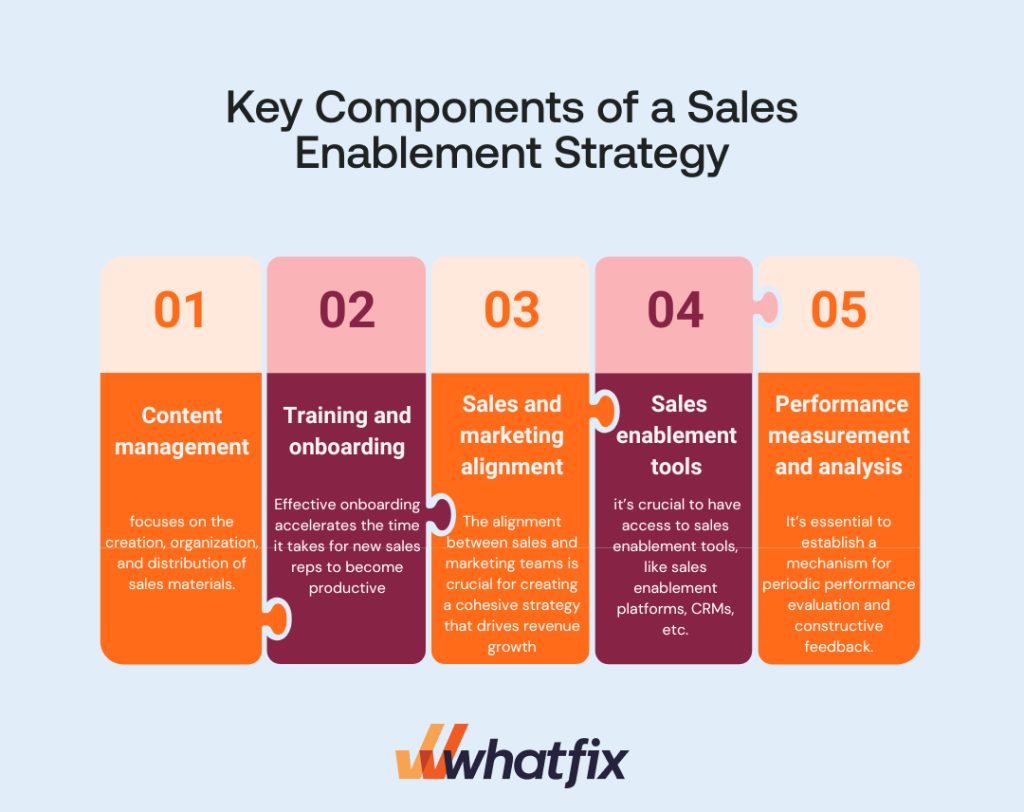
Here are seven best practices to ensure your sales enablement strategy is successful in 2022:
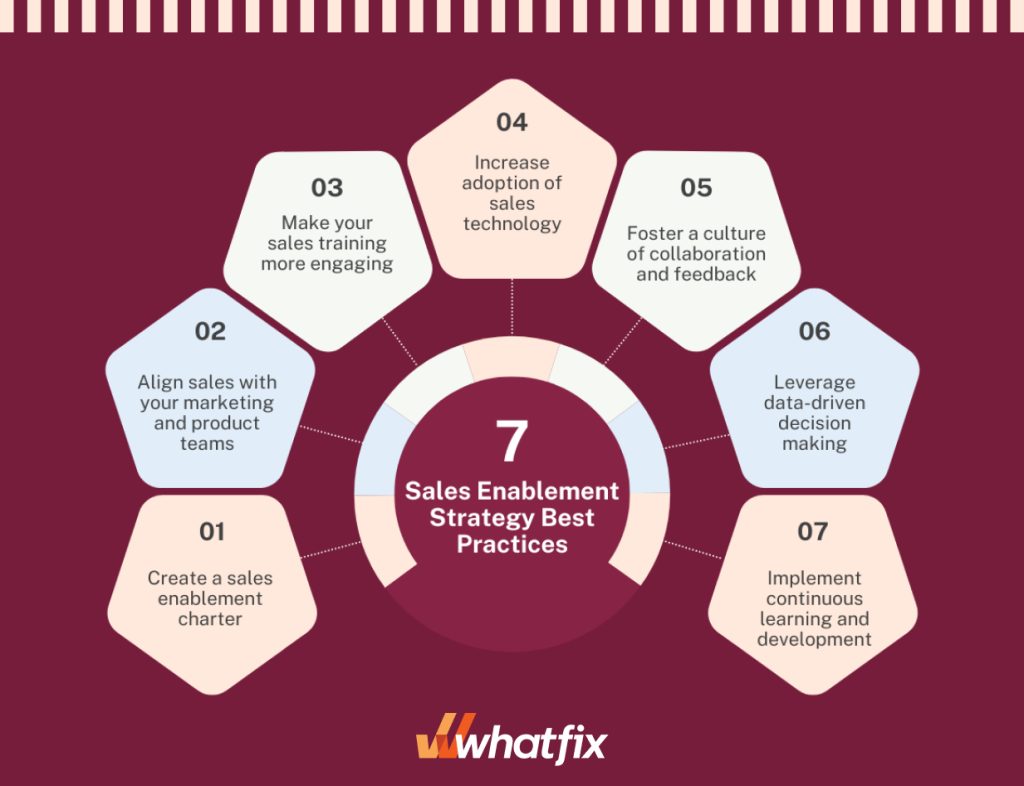
A sales enablement charter outlines the purpose, scope, and goals of sales enablement within your organization. Without this document to keep your sales enablement strategy focused, your enablement team may be pulled in various directions and become a dumping ground for activities that no other team wants to do.
A sales enablement charter should include the following:
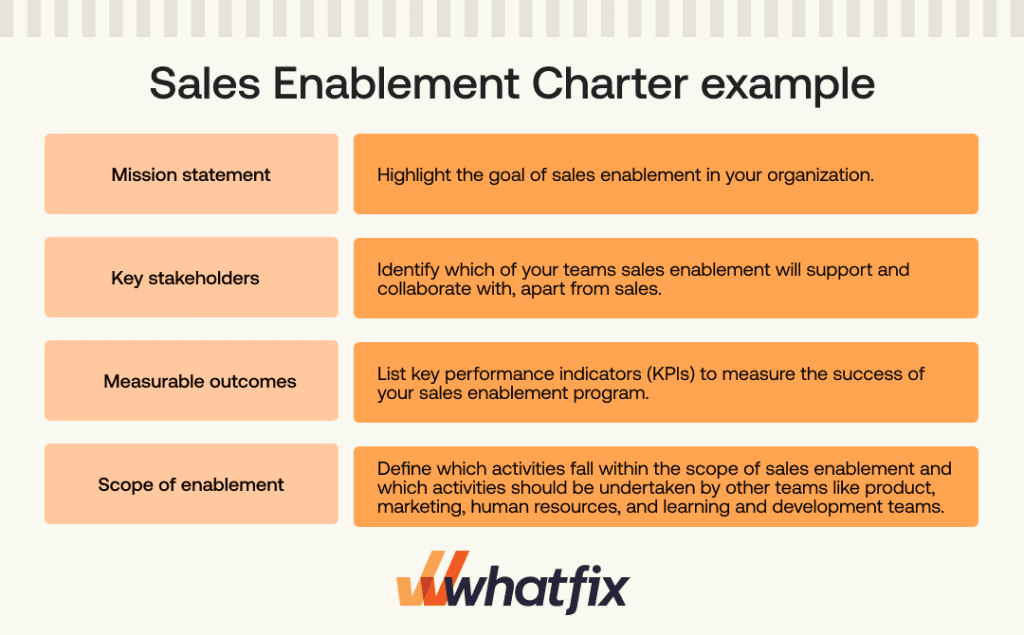
Susan Savona, vice president of global sales enablement at Monster Worldwide, suggests keeping your sales enablement charter short and to the point, so readers can quickly gauge the role of sales enablement in your business.
The better users can understand your sales enablement vision from your charter, the more focused they will be on enablement activities that matter.
A sales enablement strategy can quickly fall apart if your sales, marketing, and product teams operate on different planes in terms of goals, strategy, and understanding of target buyers.
Misalignment between marketing and sales can result in low-quality leads for sellers to pursue. It may also cause reps to short-sell your product, or sell features that are not yet fully developed.
Here are some ideas to make sure your marketing, product, and sales teams are on the same page:
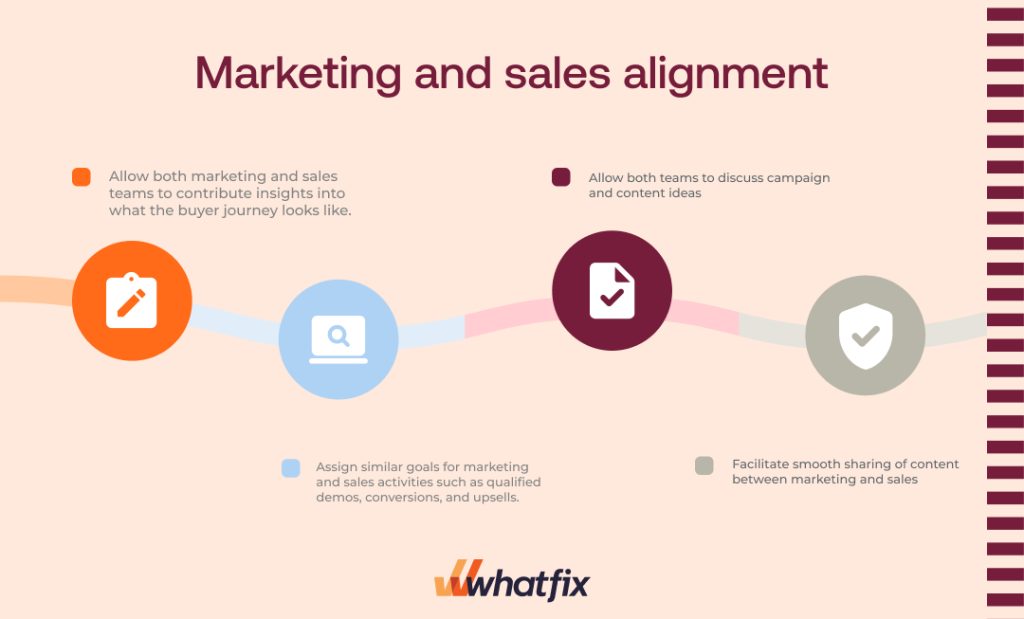
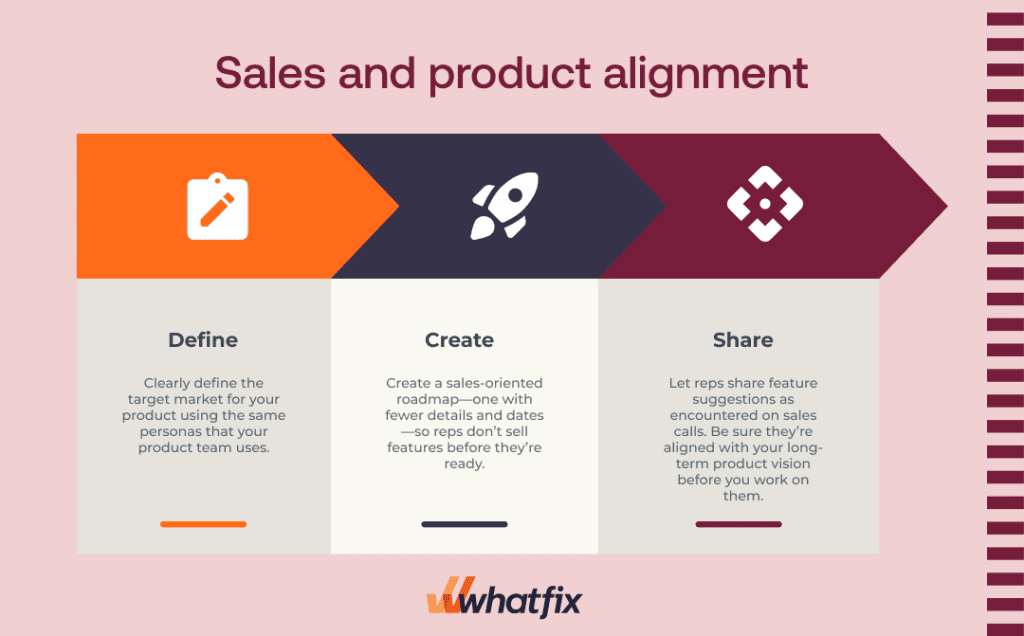
It also helps to allow sales managers to drop in on weekly meetings with product and marketing teams to understand where they’re headed and glean any useful insights for reps.
At the end of the day, each of your teams wants to enable sales in some way. Ensuring your sales, product, and marketing teams are tightly knit is the best way to reach this shared goal faster.
Coaching and training are essential components of every sales enablement strategy. But when coaching is “traditional, lecture-style, and one-size-fits-all,” sales reps are likely to lose interest. This can hamper the effectiveness of your sales enablement plan.
Ben Cotton, former sales enablement manager at HubSpot, suggests personalizing it to make sales coaching interesting. “Meet with reps individually to answer their questions, analyze their needs, and ask them to create their own program from a menu of topics.”
Cotton also suggests stepping away from “slide-heavy” and “overly structured” training sessions and keeping more time for “white-boarding, discussion, and coaching.” This ensures trainers focus on areas that reps care about.
Personalized sales training coupled with a focus on discussion helped HubSpot achieve a 31% improvement in quota attainment, according to Cotton. Sales training can be a valuable sales enablement tool, provided you make it beneficial for agents first.

BEN COTTON
FORMER SALES ENABLEMENT MANAGER AT HUBSPOT
Most sales reps say sales technology, like CRMs and collaboration tools, are a big part of their daily and weekly work, so it makes sense to feature sales technology and tools in your sales enablement strategy. But sales tech can only be helpful to your reps if they adopt it well or use its features on an ongoing basis. Otherwise, it can be a hindrance to their workflow and your sales enablement efforts.
To ensure sales reps use sales technology as intended, improve training and onboarding for these tools. Traditional training and onboarding rely on one-time demos and a static library of self-help content. This can be unhelpful, as sales software like Salesforce and Microsoft Dynamics 365 are loaded with complex features and difficult to master in a single sitting.
To help reps better retain features and actions within sales apps, offer personalized, real-time, and ongoing training so reps can learn how to use an app at their own pace. Offer different training modules according to their role, and allow reps to access training material in real-time so they can quickly reference how to perform key actions while they’re using it.
A digital adoption platform (DAP) like Whatfix can help you implement personalized, real-time training at scale. Whatfix offers in-app guidance for sales tools in the form of step-by-step walkthroughs, popups, and tooltips. It’s the best way to ensure sales technology adoption and make your sales enablement strategy a success.
Creating a culture that values collaboration and feedback is essential for a dynamic and effective sales enablement strategy. Encouraging open communication between the sales team and other departments to share insights, success stories, and challenges promotes continuous learning and adaptation, ensuring that sales strategies remain relevant and impactful. Feedback from sales reps on the front lines can guide the refinement of sales processes, training programs, and content, making them more aligned with real-world needs and customer interactions.
Implementing regular feedback loops, where sales representatives can share their experiences and suggestions, not only enhances the sales enablement strategy, but also boosts morale and engagement among team members. Recognizing and acting on feedback demonstrates to sales reps that their insights are valued, fostering a sense of ownership and commitment to the organization’s success.
In today’s competitive landscape, basing decisions on data rather than intuition is crucial for sales enablement success. Using analytics to understand sales activities, buyer behaviors, and market trends allows businesses to identify what’s working and what isn’t, enabling teams to focus their efforts on the most effective strategies and tools. Data-driven insights can also help in personalizing sales approaches to meet the specific needs of prospects and customers, increasing the likelihood of successful outcomes.
Investing in analytics tools that integrate with your existing sales and marketing platforms can provide a holistic view of the customer journey, from initial engagement to conversion. By analyzing this data, sales and marketing teams can work together to refine their strategies, ensuring they are targeting the right audiences with the right messages at the right time.
Continuous learning and development opportunities are key to keeping the sales team updated and adaptable to the ever-changing business landscape. This involves not only initial training on sales processes and products, but also ongoing education on market trends, customer needs, and emerging technologies. By investing in the continuous growth of your sales team, you can ensure they have the skills and knowledge they need to engage effectively with prospects and customers.
Offering a mix of in-person workshops, online courses, and on-the-job training can cater to different learning preferences and schedules, making it easier for sales reps to engage with the material. Additionally, incorporating mentorship programs and peer learning sessions can facilitate knowledge sharing and reinforce a supportive team environment. Continuous development initiatives signal to your team that the organization is committed to their professional growth, which can improve retention and attract top talent.
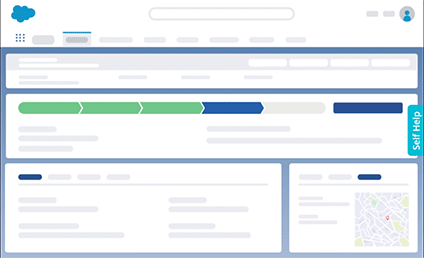
Measuring the success of a sales enablement strategy is essential for understanding its impact and identifying opportunities for optimization. These indicators provide a comprehensive view of your strategy’s effectiveness, highlighting areas of success and pinpointing aspects that need fine-tuning.
By systematically assessing the performance of their sales enablement strategy, businesses can make informed decisions that drive continuous improvement, ensuring that their sales force remains agile, effective, and aligned with the evolving demands of the market.
To effectively measure the success of your sales enablement strategy, it’s crucial to identify and track KPIs. These metrics should align with your overall business goals and sales objectives, providing insights into how well your sales team is adopting and benefiting from the enablement tools and training they’ve been given. Common metrics include:
By closely monitoring these figures and more, businesses can assess the direct impact of their sales enablement efforts on sales outcomes, identifying areas of success and those requiring improvement.
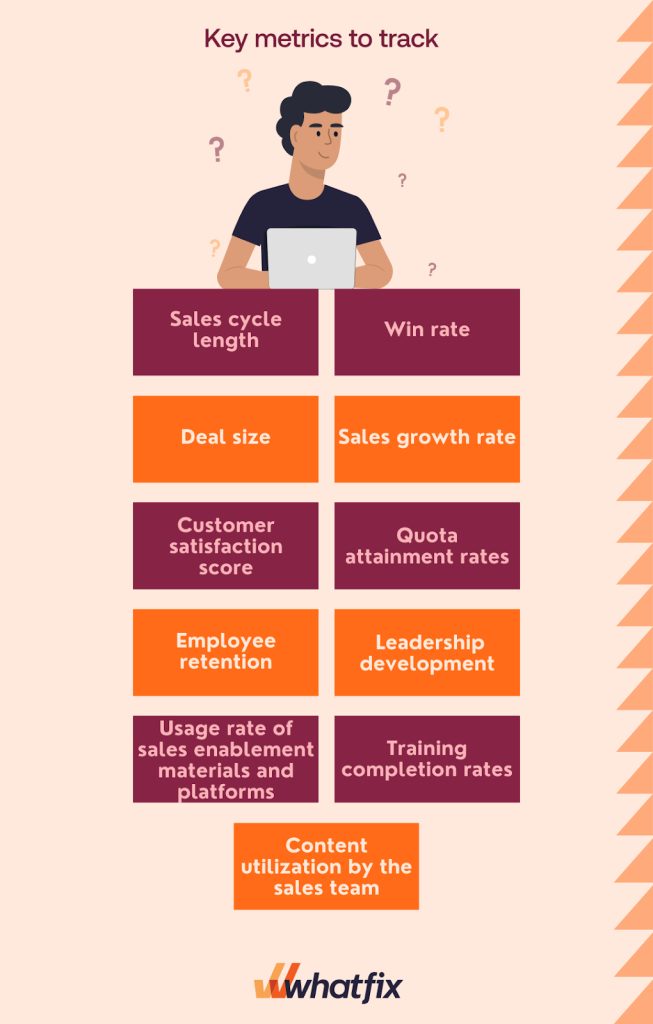
Leveraging the right tools for analysis and reporting is fundamental in accurately measuring the success of your sales enablement strategy. Sales enablement platforms often come with built-in analytics and reporting features that allow managers to track the performance of sales content, training modules, and overall sales metrics in real time. These tools can automate the collection of data across various metrics, providing a comprehensive overview of sales performance and enablement effectiveness. Advanced analytics tools can also offer predictive insights, helping to forecast sales trends and identify potential areas for future growth or improvement.
Whatfix’s advanced analytics tools go beyond basic reporting; the DAP offers predictive insights, helping to forecast sales trends and identify potential areas for future growth or improvement. By integrating Whatfix into your sales enablement strategy, you gain access to actionable data that can drive decision-making and optimize sales processes. The platform’s ease of use and seamless integration with existing systems make it an ideal choice for companies looking to enhance their sales enablement efforts and ensure their teams are equipped to meet and exceed sales targets.
The dynamic nature of sales and market demands requires a sales enablement strategy that’s both flexible and adaptable. Regularly reviewing performance data allows organizations to identify trends and patterns that may necessitate adjustments to the strategy. For example, if certain types of sales content consistently underperform or are rarely utilized, it may indicate a need for reevaluation and redevelopment of those resources. Similarly, if data reveals that sales personnel are struggling with specific stages of the sales cycle, targeted training programs can be introduced to address those areas.
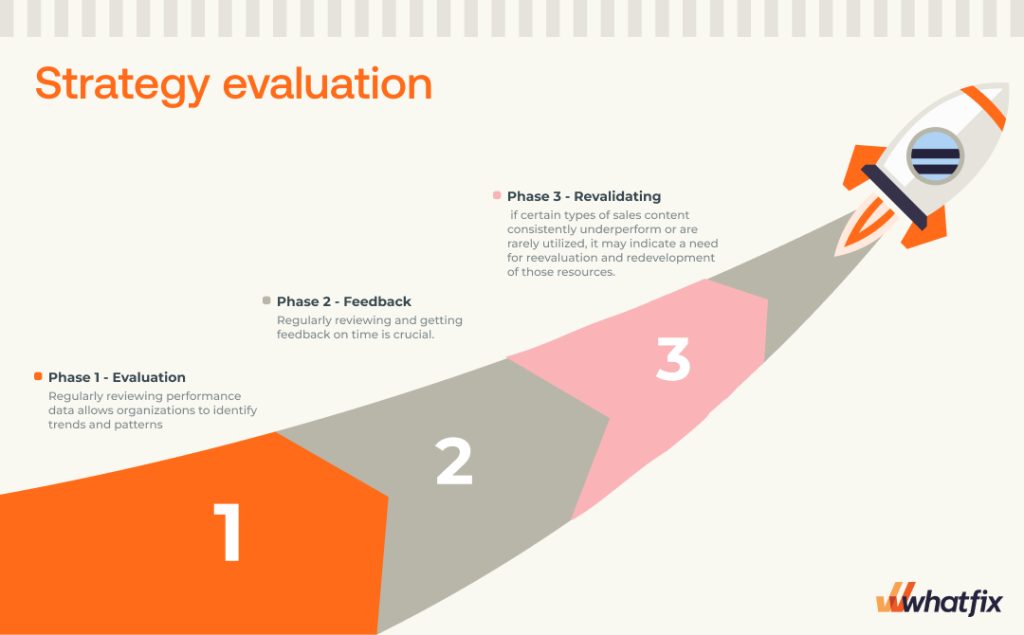
Another critical measure of sales enablement success is customer feedback and satisfaction levels. Sales enablement isn’t just about empowering sales teams; it’s ultimately aimed at improving the customer buying experience. By collecting and analyzing customer feedback through surveys, social media monitoring, and direct interactions, businesses can gauge how effectively their sales enablement strategy is translating into positive customer experiences. High levels of customer satisfaction are often indicative of a successful enablement strategy, as they reflect the sales team’s ability to engage, inform, and provide value to prospects and clients effectively.
Tracking customer retention and repeat business rates offers additional insight into the long-term impact of your sales enablement efforts. A strategy that leads to higher retention rates suggests that the sales team is effectively using enablement tools and resources to build strong, lasting relationships with customers. This metric is particularly important in understanding the enablement strategy’s role in fostering loyalty and driving sustainable growth.
Monitoring changes in market share can provide a broader perspective on the success of your sales enablement strategy. An increase in market share indicates that your sales team is not only meeting, but exceeding the performance of competitors, most likely due to the effectiveness of the sales enablement initiatives in place. This growth suggests that the strategy is effectively equipping sales representatives with the skills, knowledge, and resources needed to outperform the competition and capture a larger portion of the market.
Evaluating market share changes requires access to industry data and may involve more complex analysis, but it offers invaluable insights into the competitive advantages gained through your sales enablement efforts. As market dynamics shift, continuously aligning your sales enablement strategy with broader market trends and customer needs can help sustain and accelerate market share growth, solidifying your company’s position as a leader in its industry.

Sales enablement is the process of empowering sales teams with the right content, leadership, tools, and training they need to sell at their most efficient and productive level.
Crafting a dynamic sales enablement strategy marks the beginning of a transformative journey for sales teams, emphasizing the achievement of sales targets and the holistic enhancement of the sales process. Central to this transformative journey is the integration of innovative solutions that empower sales teams with the knowledge, skills, and resources they need to excel. Whatfix emerges as a pivotal partner in this endeavor, offering a suite of tools designed to bridge the gap between sales goals and actual performance.
Whatfix stands out by simplifying the adoption and mastery of sales processes through intuitive, real-time guidance. The hands-on in-app support system ensures that sales reps can effortlessly integrate these tools into their daily workflows, enhancing productivity and enabling a deeper focus on customer engagement.
Whatfix’s Self Help widget acts as an on-demand knowledge base, allowing sales representatives to access training materials tailored to their unique roles and levels of expertise. This level of customization ensures that every member of your team, regardless of their seniority, receives the right guidance at the right time, significantly reducing the learning curve associated with new tools and technologies.
By partnering with Whatfix, organizations can reduce training times, accelerate the deployment of new sales tools, and boost the overall adoption of sales technology. This partnership streamlines the technological aspect of sales enablement and enriches the strategy with insights and analytics, driving informed decision-making and strategic planning.
Incorporating Whatfix into your sales enablement strategy offers a clear path to empowering your sales force, ensuring they are equipped to meet the evolving demands of the sales landscape. This strategic partnership enables organizations to not just meet their sales targets but to exceed them, fostering a culture of continuous improvement and innovation.
Discover how Whatfix can amplify the impact of your sales enablement strategy, making it more effective, engaging, and aligned with your business objectives.

Thank you for subscribing!